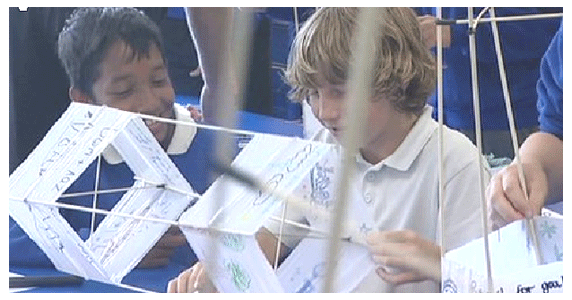 England will celebrate the 100th Anniversary of a famous early aircraft at the upcoming Bristol International Kite Festival at the end of July, 2010. Part of the celebration features a launch of one hundred small, replica box kites constructed by students in Bristol area schools.
England will celebrate the 100th Anniversary of a famous early aircraft at the upcoming Bristol International Kite Festival at the end of July, 2010. Part of the celebration features a launch of one hundred small, replica box kites constructed by students in Bristol area schools.
The story of the students building kites and some information on the celebrated aircraft, the Bristol Box Kite, is featured in a BBC story entitled “Replica Boxkites celebrate aviation history with ascent”.
The Bristol Box Kite (the actual name of the early English airplane) flew for the first time on July 29, 1910 in Bristol, England.
Based on a successful design by Henri Farman, a French aviation pioneer, the Bristol Box Kite airplane was the first production airplane in the world with 76 units built by the Colonial Airplane Company in Bristol before a major design upgrade. The design was so similar to the original Farman airplane that Farman threatened legal action. Although no documents attest to this, it is rumoured that the manufacturer paid a license fee for each plane produced to Farman.
Sixty of the 76 production units were produced for the British War Ministry while the remaining twelve units went to the armed forces of Australia, Bulgaria, Russia, South Africa, and Spain. In spite of their fragile appearance, so typical of early aircraft, small numbers of the Bristol Box Kite remained in service with the England’s RAF as two-seat training aircraft during the early part of WWI.
The airplane is very famous and was featured in the 1965 movie “Those Magnificent Men in Their Flying Machines”. A successful flying replica built for the movie by 20th Century Fox was later sold to the British Aircraft Corporation at Filton, Bristol, England. The corporation presented the plane to Bristol's City Museum & Art Gallery in 1965 where it has been on display ever since.
The fact that this airplane was created and flown seven years after the flight of the Wright Flyer and two years later than the Aerial Experiment Association’s five pioneering aerodromes: the Cygnet (giant tetrahedral kite), the Red Wing, the White Wing, the June Bug, and the Silver Dart attests to the slow, measured progress in the development of early aircraft.
Steps in getting people successfully and safely into the air were very slow in the early stages. The principles of flight had been discovered and detailed by Sir George Cayley in 1799. Often named as the first person to understand the underlying principles and forces of flight, Cayley built a pioneering model glider in 1804 that successfully demonstrated that a device could be constructed to master the four aerodynamic forces of flight—weight, lift, drag, and thrust. Cayley’s glider used “push” as the source of thrust since no light weight power sources that could propel a structure aloft carrying a person were available until the early 1900’s. Once light weight engines were developed and supporting fuselage and wing structures were advanced enough, the Wrights, the AEA, and French and Brazilian aviation pioneers began building actual powered airplanes.
It is great to see the young students building box kites to fly at the Bristol International Kite Festival later this month. This is a great way to draw another generation of kiters into the wonder of tethered flight. Another 100th anniversary milestone of flight that links back to kites!
